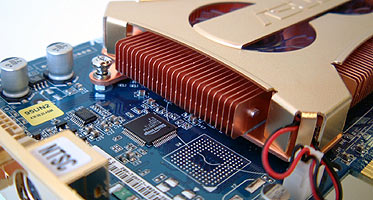Asus uses a single slot copper
HSF on the front of the videocard and a large aluminum heat spreader on the
back. Unlike the reference nVIDIA GeForceFX 5900 Ultra, the cooling solution
Asus employs only takes up one slot - although I doubt you'd want to use the
first PCI slot anyway.
Instead of flimsy clips, the
heatsink attaches with screws, springs, plastic washers and nuts. This certainly
makes the HSF more sturdy. A nice amount of thermal paste is applied between the
GPU/memory and heatsink. The rear heat spreader comes in direct contact with the
rear of the PCB to gather as much heat as possible from the GPU. The V9950 Ultra
was the coolest running GeForceFX 5900 Ultra we have tested to date.

The two 40mm GPU
fans that Asus uses are extremely quiet even when running in 3D mode. In terms
of noise I'd say they're easily as quiet as the Radeon 9800 Pro HSF.
With most of its
competition fully VIVO compatible, I was a bit disappointed to see that the Asus
V9950 Ultra only supported S-Video out (despite it saying VIVO on the I/O
plate!). You'd expect the best when you're shelling out $500+ for a
videocard!
Two user manuals
are included with the V9950 Ultra, but neither are very detailed and novice
users may have problems following the instructions. This was surprising as the
Asus videocards I have owned in the past always had well detailed
manuals.
If you're
interested to learn a bit more about GeForceFX 5900 Ultra technology or take a
look at some image quality shots (compared to an ATi Radeon 9800 Pro) please
check out our Albatron GeForceFX 5900PV
review. Next up, for the enthusiasts
out there we handle a little overclocking goodness.
